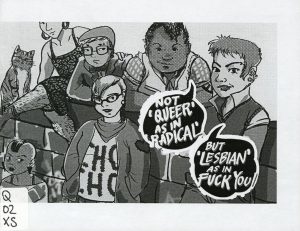The above link is to purchase the book from an online queer bookstore in Colorado. Alternatively, check out this link for a list of queer bookstores around the world, and consider purchasing the book from one of these options: https://queerhistory.com/queer-booksellers. Support queer businesses!
Since the legalization of gay marriage in 2016, many scholars contend we have entered into a ‘post-gay’ society wherein homosexuality has finally achieved mainstream status, and gays have assimilated. Jen Jack Gieseking’s book, A Queer New York, debunks this myth. Based on research collected between 2008 and 2009, A Queer New York explores the historical significance of lesbian and queer spaces in New York City, specifically in well-known neighborhoods such as Greenwich Village, Park Slope, Bedford-Stuyvesant, and Crown Heights. He asserts, however, “long-term, owned territorial spaces associated with LGBTQ people – e.g. neighborhoods, bars, and cities – do not support how lesbians and queers produce…everyday urban spaces” (xvi). These ‘territorial spaces,’ such as gayborhoods, became associated with LGBTQ populations due to research on white, cisgender, (mostly) wealthy, gay men. Gieseking pushes his readers (and other queer studies scholars) to resist the association of gayborhoods with queer placemaking, asserting that model has never accurately represented the diverse ways in which lesbians and queers engage in community.
Gieseking, himself a ‘queer, lesbian, butch, trans dyke,’ set out to explore how gentrification in New York City, which led to the disappearance of many lesbian and queer spaces, has impacted poor and working-class lesbians and queers. With the help of archival research and a series of multigenerational interviews, Gieseking crafted a much-needed, never-before-told lesbian-queer historical geography of NYC that allows his readers sight of the invisible (or overlooked).

Lesbians and Trans- and Gender Non-Conforming people (tgncp) have seldom anchored sociological research. Scholars have traditionally incorporated them within an analytical framework that relies on terms centering the practices of gay men. Resisting these limited definitions of lesbian and queer lives, Gieseking developed constellations, evoking the imagery of astronomical constellations and astrology, to understand how lesbians and queers produce urban space. Within this framework, each individual lesbian-queer space is a star, and lesbian-queer placemaking only become visible when one views stars, and their paths, in relation to one another. This concept leaves room to understand that just because lesbian and tgncp do not (or more likely: cannot) lay claim to physically owned property or territory, that doesn’t mean that they do not create spaces for themselves. Rather, these spaces are as fleeting, fluid, and ever-present as stars – even when they are unseen to the rest of the world.
Gieseking presents various examples of constellations that contrast to the territorial placemaking that gay men often forged in gayborhoods. His interviewees articulate the lengths they go to just to see other lesbian-queers in the face of constantly-changing and rapidly-gentrifying NYC. One woman remembers commuting an hour or more to a bar frequented by other lesbian-queers. Another attended a house party hosted by a friend’s ex. Many interviewees even hung out in Park Slope with the hopes that a lesbian would approach. Moreover, Gieseking’s interview data reveal the added challenge many queers of color experience when accessing queer community. One interviewee, a multiethnic, working-class, feminine woman named Dana “talked at length both about the time, money, and effort required by queer women of color to find one another, and the limits to connecting to the Black and Latinx queer women’s and tgncp’s scene” (123). Interviewees of color described their need to resist not only heteropatriarchy but also racism and classism. A Queer New York amplifies the voices of lesbians and queers of color and holds white queers and lesbians accountable for their own colonialist, racist, capitalist ways of producing space in the city.
Furthermore, Gieseking argues that white lesbian and queers in NYC are both gentrifiers and victims of gentrification. He provides evidence that lesbian and queers’ gathering in an area of the city leads to price inflation, which then eventually displaces them as wealthier, (often) whiter heterosexual couples move in. As a result of this vicious cycle of capitalism-colonialism and displacement, lesbians and queers are forced to access queer community in constellations.
I highly recommend reading this book, especially if you are a queer woman or tgncp, someone who studies queerness, is interested in queer history, or someone familiar with the city’s different regions. Although Gieseking provided figures of maps throughout the book, I found sections of the book challenging to maintain my interest due to the in-depth geographical history provided. This is likely because I am not a trained geologist and have never studied geography. I acknowledge the importance of and contributions of geography to this study. Still, I question the study’s accessibility to audiences unfamiliar with New York City and who do not study geography.
Gieseking’s concept of constellations aptly describes how lesbian and tgncp carve out space in NYC. However, I also question whether his theory applies outside of NYC. I would imagine that constellations can also describe lesbian and tgncp behavior in other cities in the U.S., but does it apply to rural areas? Suburban areas? What about online communities? This question is especially relevant to me, as I’ve conducted my own research on virtual communities of queer women and non-binary people. I wonder, how does Gieseking’s theory hold up when applied to communities that do not rely on physical space to create a place for themselves? Gieseking asserts “these places are carried in, and on these women’s and tgncp’s memories and bodies, in the paths they continue to take between these stars” (xvii). A beautiful sentiment, for sure, and powerful (re)interpretation and empowerment of a community that has too often been rendered invisible, but I’m not so sure if his theory is strong enough to allow for application outside of these very specific circumstances. Only time will tell!